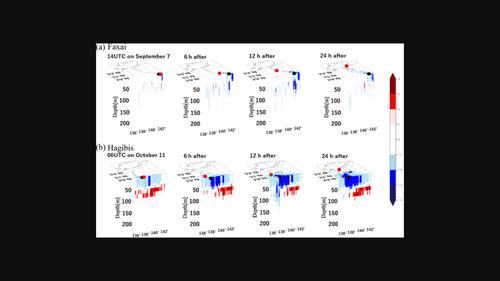当前位置:
X-MOL 学术
›
Atmos. Sci. Lett.
›
论文详情
Our official English website, www.x-mol.net, welcomes your feedback! (Note: you will need to create a separate account there.)
Quantification and attribution of ocean cooling induced by the passages of typhoons Faxai (2019) and Hagibis (2019) over the same region using a high-resolution ocean model and cooling parameters
Atmospheric Science Letters ( IF 3 ) Pub Date : 2023-05-01 , DOI: 10.1002/asl.1169 Koki Iida 1 , Hironori Fudeyasu 2 , Yuusuke Tanaka 3 , Satoshi Iizuka 4 , Yoshiaki Miyamoto 5
Atmospheric Science Letters ( IF 3 ) Pub Date : 2023-05-01 , DOI: 10.1002/asl.1169 Koki Iida 1 , Hironori Fudeyasu 2 , Yuusuke Tanaka 3 , Satoshi Iizuka 4 , Yoshiaki Miyamoto 5
Affiliation

|
This study quantitatively evaluated the typhoon-induced sea surface temperature (SST) cooling caused by typhoons Faxai (2019) and Hagibis (2019) using a high-resolution ocean model and the cooling parameter (Co). Faxai and Hagibis both passed over the ocean south of the eastern part of the Japanese main island, but the associated average SST decreases differed. Faxai produced a decrease of less than 2°C, whereas Hagibis produced a decrease of more than 2°C. The average Co value was 1.6 for Faxai and 3.6 for Hagibis, indicating that SST was more easily cooled by Hagibis than by Faxai, consistent with the observations. The impact of ocean conditions on the typhoon-induced SST cooling by Hagibis was 2.6 times larger than the impact by Faxai, indicating that the ocean before Hagibis passes is less hard to cool ocean than Faxai. In short, it is important for ocean cooling not only ocean conditions but also typhoon characteristics because in fact, Hagibis cooled the ocean more than Faxai. In addition, the impact of Hagibis's characteristics on the typhoon-induced SST cooling was 4.8 times larger than the impact of Faxai's characteristics. Thus, SST was more likely to cool by typhoon characteristics in the case of Hagibis. In particular, among Hagibis's characteristics, typhoon size in the horizontal direction had the most efficient effect on SST cooling. Although Co does not consider the effects of the advection of ocean water, we suggest that Co is a practical indicator for estimating SST cooling caused by a typhoon and comparing factors of typhoon-induced SST cooling in multiple cases.
中文翻译:

使用高分辨率海洋模型和冷却参数对台风“法赛”(2019 年)和“海贝思”(2019 年)经过同一地区引起的海洋冷却进行量化和归因
本研究利用高分辨率海洋模型和冷却参数(Co)定量评估了台风“法赛”(2019)和“海贝思”(2019)引起的台风引起的海面温度(SST)冷却。Faxai和Hagibis均经过日本本岛东部以南的海洋,但相关的平均海温下降幅度不同。Faxai 的降温幅度小于 2°C,而 Hagibis 的降温幅度超过 2°C。Faxai 的平均 Co 值为 1.6,Hagibis 的平均 Co 值为 3.6,这表明 Hagibis 比 Faxai 更容易冷却海表温度,这与观测结果一致。海洋条件对海贝斯台风引起海温降温的影响比法赛影响大2.6倍,表明海贝思经过前的海洋比法赛降温难度要小。简而言之,它不仅对海洋冷却很重要,而且对台风特征也很重要,因为事实上,海贝思比法赛对海洋的冷却作用更大。此外,海贝思特征对台风引起的海温降温的影响是法赛特征影响的4.8倍。因此,就海贝思而言,海温更有可能因台风特征而变冷。特别是,在海贝思的特征中,水平方向的台风大小对海温降温的影响最为有效。尽管Co没有考虑海水平流的影响,但我们认为Co是估算台风引起的海表温度变冷并比较多种情况下台风引起的海表温度变冷因素的实用指标。
更新日期:2023-05-01
中文翻译:

使用高分辨率海洋模型和冷却参数对台风“法赛”(2019 年)和“海贝思”(2019 年)经过同一地区引起的海洋冷却进行量化和归因
本研究利用高分辨率海洋模型和冷却参数(Co)定量评估了台风“法赛”(2019)和“海贝思”(2019)引起的台风引起的海面温度(SST)冷却。Faxai和Hagibis均经过日本本岛东部以南的海洋,但相关的平均海温下降幅度不同。Faxai 的降温幅度小于 2°C,而 Hagibis 的降温幅度超过 2°C。Faxai 的平均 Co 值为 1.6,Hagibis 的平均 Co 值为 3.6,这表明 Hagibis 比 Faxai 更容易冷却海表温度,这与观测结果一致。海洋条件对海贝斯台风引起海温降温的影响比法赛影响大2.6倍,表明海贝思经过前的海洋比法赛降温难度要小。简而言之,它不仅对海洋冷却很重要,而且对台风特征也很重要,因为事实上,海贝思比法赛对海洋的冷却作用更大。此外,海贝思特征对台风引起的海温降温的影响是法赛特征影响的4.8倍。因此,就海贝思而言,海温更有可能因台风特征而变冷。特别是,在海贝思的特征中,水平方向的台风大小对海温降温的影响最为有效。尽管Co没有考虑海水平流的影响,但我们认为Co是估算台风引起的海表温度变冷并比较多种情况下台风引起的海表温度变冷因素的实用指标。



























 京公网安备 11010802027423号
京公网安备 11010802027423号